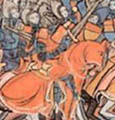![]() Robert's crusade
Robert's crusade
William Rufus in Normandy ![]() Robert on Crusade
Robert on Crusade
Pope Urban II's call for a crusade brought a period of calm to Normandy. The end of the private wars was one of the requirements imposed on the barons during the time of the crusade. Robert Curthose renewed his youthful adventurousness and decided to take up the cross. William Rufus was present at the departure of his brother in September 1096. As he departed, Robert left him the Duchy of Normandy in exchange for his financial aid for the costs of his expedition and for equipping his large troop.
 The
absence of Robert gave William the chance to re-establish order in Normandy,
but he found himself facing the same difficulties as his father, the Conqueror.
For three years William Rufus had to hold onto his frontiers at every limit of
his domain. The threats from the King of Norway were added to the conflicts
with the Welsh and the Scots. While in Normandy there was a constant struggle
for the control of Maine and Vexin, without any clear outcome being achieved.
The imposing fortress of Gisors, which is first recorded in 1097, bears
witness to the resources applied in an area where the frontier of Normandy was
defined.
The
absence of Robert gave William the chance to re-establish order in Normandy,
but he found himself facing the same difficulties as his father, the Conqueror.
For three years William Rufus had to hold onto his frontiers at every limit of
his domain. The threats from the King of Norway were added to the conflicts
with the Welsh and the Scots. While in Normandy there was a constant struggle
for the control of Maine and Vexin, without any clear outcome being achieved.
The imposing fortress of Gisors, which is first recorded in 1097, bears
witness to the resources applied in an area where the frontier of Normandy was
defined.
According
to Orderic Vitalis, the Duke of Normandy, unable to impose the rule of peace
and justice in his Duchy, was converted by the prayers of a religious man,
shortly after the appeal by Pope Urban II at the Council of Clermont (1095),
and decided to set off for Jerusalem.
Robert Curthose was not, just a pilgrim, however. He was one of the leaders of
the First Crusade at the head of large and richly resourced troop, accompanied
by, amongst others, his relatives Stephen of Blois and Robert of Flanders, his
uncle Odo, Bishop of Bayeux, who died en route and was buried in Palermo, and
Hugh, brother of the King of France.
 The
Duke of Normandy set off for Rome in September 1096. He spent the winter in
Puglia, with the Norman Count Roger Borsa. Robert's army did not join the
other crusader princes in Constantinople or at the siege of Nicea until May
1097. Robert's prowess was then presented as exemplary by all the chroniclers,
but he was unable to find a herald to sing his praises, as the monk Raoul de
Caen did for another Norman, Tancred, nephew of Bohemond of Tarento. One
therefore finds the epic deeds of Robert cited amongst those of other men, but
always in the first rank, at the battle of Dorylaeum (1 July 1097), at the
siege of Antioch (Oct. 1097 - June 1098), and at the siege and capture of
Jerusalem (June - July 1099). His most famous exploit remains the seizing of a
standard from the leader of the Egyptian army intercepted at Ascalon on 12
August 1099.
The
Duke of Normandy set off for Rome in September 1096. He spent the winter in
Puglia, with the Norman Count Roger Borsa. Robert's army did not join the
other crusader princes in Constantinople or at the siege of Nicea until May
1097. Robert's prowess was then presented as exemplary by all the chroniclers,
but he was unable to find a herald to sing his praises, as the monk Raoul de
Caen did for another Norman, Tancred, nephew of Bohemond of Tarento. One
therefore finds the epic deeds of Robert cited amongst those of other men, but
always in the first rank, at the battle of Dorylaeum (1 July 1097), at the
siege of Antioch (Oct. 1097 - June 1098), and at the siege and capture of
Jerusalem (June - July 1099). His most famous exploit remains the seizing of a
standard from the leader of the Egyptian army intercepted at Ascalon on 12
August 1099.
 Jerusalem
having been delivered, Robert Curthose, like many other crusaders, considered
his task to be completed and headed home. Unlike the Norman princes of Italy,
Robert is notable for not seeking to carve himself out a domain from the re-conquered
lands. He was preoccupied with gathering the funds required to release his
Duchy, and received a donation from the Emperor of Constantinople, Alexius
Comnenus, to whom he had sworn an oath of loyalty, as well as the dowry of
Sybil of Conversano whom he married during a final stay with the Normans of
Italy in the winter of 1099.
Jerusalem
having been delivered, Robert Curthose, like many other crusaders, considered
his task to be completed and headed home. Unlike the Norman princes of Italy,
Robert is notable for not seeking to carve himself out a domain from the re-conquered
lands. He was preoccupied with gathering the funds required to release his
Duchy, and received a donation from the Emperor of Constantinople, Alexius
Comnenus, to whom he had sworn an oath of loyalty, as well as the dowry of
Sybil of Conversano whom he married during a final stay with the Normans of
Italy in the winter of 1099.
When he finally returned to Normandy in Spring 1100, Robert recovered his Duchy without having to reimburse his brother William Rufus, who in the meantime had died, but he could consider himself stripped of his birthright, the English crown, which was taken before his return by Henry I 'Beauclerc'.